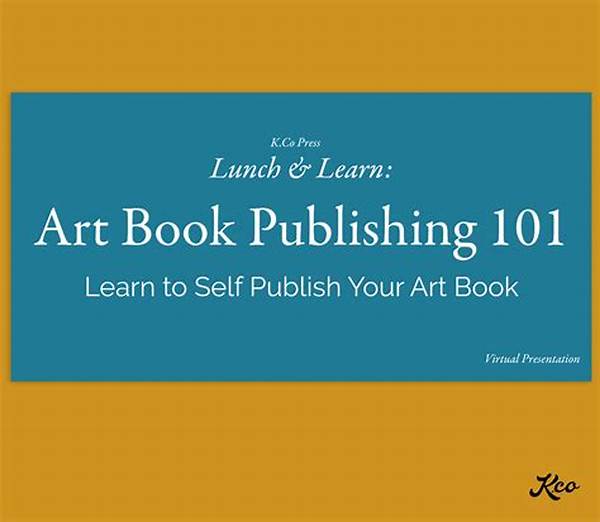In today’s digital age, artists have incredible opportunities to share their creations with a global audience without the need for traditional publishing houses. Self-publishing your art collection enables you to take control of how your work is presented and shared, offering unparalleled creative freedom. Whether you’re an emerging artist or an established name, this process can help you reach new audiences and achieve a personal sense of accomplishment. In this article, we will explore various aspects of self-publishing, including its benefits, challenges, and steps you can take to successfully showcase your art to the world.
Read Now : Artist Branding On Instagram
The Benefits of Self-Publishing Your Art Collection
Self-publishing your art collection offers numerous advantages, making it a highly attractive option for many artists. Firstly, it provides complete creative control. You decide on the layout, design, and content, ensuring that your vision remains uncompromized. Additionally, self-publishing allows you to determine the pace of the project; there’s no pressure from external publishers demanding deadlines that might not align with your artistic process.
Moreover, financial aspects are significantly different. Traditional publishing often requires artists to share a substantial portion of their sales. In contrast, self-publishing gives you the autonomy to set your own price, potentially increasing your profit margins. Finally, self-publishing can also enhance your connection with your audience. Direct involvement in the marketing and distribution process allows you to engage with followers more personally, nurturing a closer relationship with those who appreciate your work.
Overcoming the challenges of self-publishing is also part of the rewarding journey. You get to learn new skills and expand your horizons beyond just art. As you navigate through aspects like editing, marketing, and distribution, you become a more versatile professional. Ultimately, self-publishing your art collection is a journey of growth and discovery, both personally and professionally.
Steps to Self-Publishing Your Art Collection
1. Conceptualization: Start by conceptualizing what you want to achieve with self-publishing your art collection. Define your goals and audience to guide your creative decisions.
2. Design and Layout: Focus on the design and layout of your art book. This is where you bring your vision to life, ensuring that each page reflects the essence of your work.
3. Quality Control: Ensure high quality in both print and digital formats. The materials and print techniques you choose can impact how your artwork is perceived.
4. Marketing Strategy: Develop a marketing strategy specific to your target audience. Self-publishing your art collection requires effective promotion to reach those who value your work.
5. Distribution Plan: Create a plan for distribution, considering both online and offline channels. This will determine how your art collection reaches your audience on a global scale.
Tools and Platforms for Self-Publishing Your Art Collection
Utilizing the right tools and platforms is crucial when self-publishing your art collection. Many platforms offer user-friendly interfaces that simplify the publishing process. Print-on-demand services like Blurb and Lulu are popular choices for artists looking to maintain quality while minimizing costs. They allow you to order books as needed, reducing inventory concerns.
For digital publications, platforms like Kindle Direct Publishing (KDP) and Apple Books offer excellent global reach. These platforms provide tools to help you format your eBook and distribute it to readers worldwide. Using social media and personal websites can further amplify your reach, letting you market your self-published art collection directly to existing and potential fans.
Choosing the right platform depends largely on your specific goals and audience. Understanding the strengths and limitations of each option will guide you to make informed choices. Whether you aim for physical prints or digital distribution, a strategic approach will enhance your success in self-publishing your art collection.
Challenges and Considerations in Self-Publishing Your Art Collection
Self-publishing your art collection does come with its own set of challenges. The lack of traditional publishing support means you need to manage various elements yourself. From editing your collection to ensuring the accurate representation of colors and imagery in print, attention to detail is paramount. Balancing both creative and business aspects requires dedication and resilience.
Another consideration is handling promotional activities. Without a publisher, attracting attention to your work falls solely on your shoulders. Building an audience and maintaining their interest through effective marketing strategies is essential. Additionally, navigating intellectual property rights and ensuring the proper legal protections for your work can be a complex process.
Read Now : Influencer Selection And Targeting Process
However, these challenges can be seen as opportunities for growth. By tackling each step with carefully planned strategies, artists can transform these potential obstacles into stepping stones for a more successful and fulfilling self-publishing journey. Self-publishing your art collection, despite its challenges, allows artists to truly own both their creative process and its outcomes.
Crafting a Personal Brand Through Self-Publishing Your Art Collection
Creating a cohesive and engaging personal brand is crucial when self-publishing your art collection. Your brand serves as a reflection of your artistic style, values, and the message you wish to convey to your audience. It’s not just about the artwork; it’s about the story you tell and how you connect with your viewers.
Start by identifying the core themes and narrative of your art collection. This forms the foundation of your brand. Whether you are focusing on abstract expressionism or illustrative storytelling, your brand should consistently communicate these elements across all platforms. Consistency in visual identity—colors, fonts, and logos—further reinforces your brand, making it recognizable.
Engage with your audience by sharing insights or the stories behind your artworks. Social media platforms and artist pages offer perfect grounds for such engagements. Feedback and interaction not only foster community but also enhance the visibility of your self-published art collection. Remember, self-publishing isn’t just about selling art; it’s about building and nurturing a community that shares your passion.
Building a Network for Self-Publishing Your Art Collection
Networking plays a vital role in the success of self-publishing your art collection. Connecting with fellow artists, art enthusiasts, and industry professionals can provide invaluable insights and opportunities. Attend art fairs, exhibitions, and workshops where you can exchange ideas and learn about the latest trends in self-publishing.
Collaborations and partnerships are also beneficial. Collaborating with other artists or writers can introduce your work to different audiences, potentially driving more interest to your art collection. Furthermore, partnerships with galleries or online platforms can enhance your visibility and credibility.
Online communities and forums dedicated to art and self-publishing are great resources for advice, support, and exposure. Sharing your journey with others who have similar interests or who have successfully self-published can offer crucial guidance. Building a robust network not only aids in self-publishing your art collection but also enriches your artistic journey.
Summary of Self-Publishing Your Art Collection
In conclusion, self-publishing your art collection presents a unique blend of opportunities and challenges. It grants artists unparalleled control over their work and the way it’s shared, allowing for complete creative and commercial autonomy. Artists can explore their vision without conforming to external demands, ensuring authenticity in their presentation.
However, self-publishing also requires considerable effort. From mastering marketing techniques to perfecting print quality, the challenges necessitate a proactive approach and continuous learning. Yet, these hurdles can transform into rewarding experiences, building more well-rounded artists and enhancing their professional profiles.
Ultimately, self-publishing your art collection empowers artists to craft a personalized narrative, build meaningful connections with their audience, and navigate new avenues for artistic expression. By embracing both the freedoms and responsibilities of self-publishing, artists can create impactful and memorable works that resonate with their audience far and wide.



